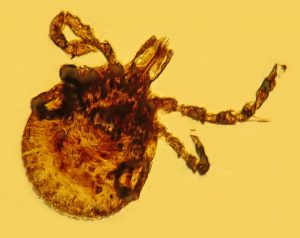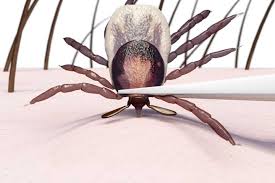Sorry to bring up a sore subject, but it’s still tick season. And will be all year round. What … during winter? Really? Yes. But for starters here’s your pop quiz:

A tick’s lifespan is
- three months
- ten months
- twenty-four months (that is, about two years)
The best way to remove a tick is to
- swab it with nail polish
- hold a hot match to its behind
- pull it straight up with fine-point tweezers
But back to our intro. Here’s the scoop: an adult female that hasn’t yet managed to grab hold of a large animal (think deer — or person) to get that all-important blood meal (can’t lay eggs without it) doesn’t want to wait around till a sunshiny summer day next year, because by then its number is up. Besides, the mice, chipmunks or birds it fed on earlier in its life cycle have only so much blood to go around. So that tick stays just below the soil where tall meadow flowers or low shrubs grow. Waiting. Waiting for a thaw barely long enough for it to scramble up one of those stems.
Waiting for the cues that tell it a warm-blooded animal is at close range. An animal that might be you.
And now for a look at our quiz. A tick’s lifespan? Your answer is (drumroll) C: upward of two years. Here’s how it works: Ticks spend a lot of time in dormancy, aka diapause. Eggs are laid in spring, tucked away out of sight. If some critter doesn’t find and eat them, they’ll hatch during summer as larval ticks (seed ticks, they’re sometimes called). Larval ticks are not infected with Lyme when they hatch — indeed, they’re pure as the fallen snow.
Meanwhile if likely hosts — those mice, chipmunks or birds — wander by, the ticks latch on. And if a host is already infected with Lyme disease or any of its nasty co-infections, those larval ticks, pure no more, are infected too.

Larvae that make it this far morph into nymphs, and it’s diapause season again as the nymphs wait it out till the following spring. Assuming these ticks are now carriers —and about 25% will be — spring is the worst time of year for us. Because these ticks are tiny enough (the infamous poppy-seed stage) that they’re easy to overlook. If you get bit, ipso facto — you get Lyme (and quite possibly a co-infection too).
Things slack off in late summer as surviving nymphs enter a diapause that lasts till the following spring. But you can’t let down your guard, since by mid-fall through winter you’ve got those adult ticks to consider. The good thing (if “good thing” there is)? While half of these sesame seed-sized ticks are infected, they’re also easier to spot and remove.
Our second quiz item? If any of these strike you as valuable folk wisdom, strike the valuable part and know it ain’t so. Nail polish? Matches? Don’t even think of it. Those first two items are just likely to tick that tick off — and it’ll vomit its gut contents into you in its hurry to get out. That is, if it can get out quickly; if it’s really drilled in, it has downloaded a cement-like substance to anchor itself. It takes some doing to disengage, however persuasive the nail polish, burnt match, or myriad other folklore remedies. (Twisting it is another no-no that comes to mind, mainly because someone asked me about it mid-way through this post.)

If you value your health, get yourself some pointy tweezers, sold for needlepoint and other crafts, and carry them with you always in your bag, backpack, or whatever you haul around. Grasp that tick as close as you can get to your skin and pull steadily. Did its mouthparts remain glued within? Not to worry — the tick will feed no more. And before too many days go by, your exfoliating skin (that’s when the top layer of skin cells drift away) will exfoliate them in turn.
With ticks, prevention can include everything from doing routine tick checks to wearing repellent clothing when you’re outdoors — regardless the season. And you can’t do much better than this for advice about dressing right.
Meanwhile here’s your catchphrase: 32, ticks on you. “32” as in 32°F. Stay watchful — and stay safe.